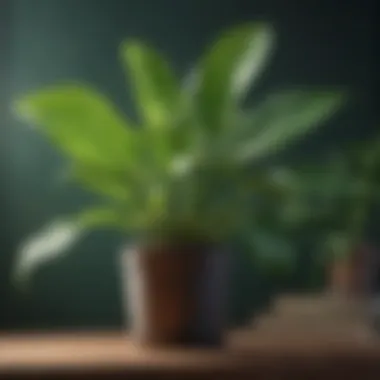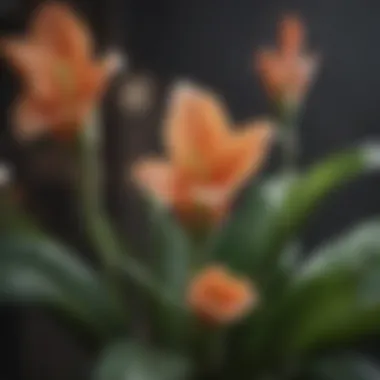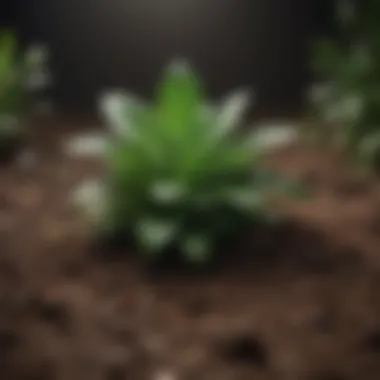Essential Care Guide for Your Peace Plant


Intro
The peace plant, commonly known as Spathiphyllum, is more than just an attractive houseplant. It serves as a symbol of tranquility and prosperity, bringing a sense of calm to the indoor environment. Understanding how to care for a peace plant is essential not only for its aesthetic appeal but also for its health and longevity. This article delves into the foundational care requirements of the peace plant, encompassing aspects such as lighting, watering, soil conditions, fertilization, pest management, and propagation techniques. By addressing these elements, individuals can create the right conditions for their peace plants to flourish.
Fascinating Facts About the Peace Plant
Unique Characteristics
Peace plants possess several distinctive features. Their dark green, glossy leaves and elegant white flowers create a striking appearance, which is often admired in both residential and commercial spaces. The flowers resemble lazy, white sails, which add a tranquil aesthetic to any room.
Moreover, peace plants are known for their air-purifying qualities. Research has shown that these plants can effectively remove toxins like formaldehyde and benzene from the air, contributing to a healthier indoor atmosphere. Their ability to adapt to low-light conditions makes them a popular choice for beginners and seasoned plant lovers alike.
Extraordinary Abilities
One of the lesser-known abilities of peace plants is their response to their environment. They can droop when they are thirsty, serving as a natural indicator for when to water them. This responsiveness makes it easier for plant owners to gauge care needs. Additionally, peace plants can grow well in various conditions, but they thrive best in consistently warm temperatures and indirect light. This versatility contributes to their popularity in a range of settings.
Care Requirements
Light Needs
Peace plants prefer moderate to low indirect light. Direct sunlight can scorch the leaves, leading to unsightly brown patches. Placing the plant near a north- or east-facing window is often ideal, as it provides sufficient brightness without the harsh rays of direct sunlight. If natural light is scarce, supplemental grow lights can support its growth.
Watering Practices
Watering is crucial to peace plant health. The key is to keep the soil moist but not waterlogged. Allow the top inch of soil to dry out between waterings. Overwatering can lead to root rot, a common problem that affects many indoor plants. Conversely, underwatering causes leaves to droop and wilt. Establishing a consistent watering schedule is beneficial for sustaining plant vitality.
Soil and Fertilization
Using a well-draining potting mix is essential for peace plants. A blend that includes peat moss, perlite, and regular potting soil provides the right texture and nutrients. Fertilization should occur during the growing season, typically from spring to early autumn. Using a balanced indoor plant fertilizer every six to eight weeks fosters healthy growth and vibrant flowers.
Pest Management
Despite their resilience, peace plants are susceptible to pests such as spider mites, aphids, and mealybugs. Regular inspections of the leaves can help catch infestations early. Utilizing neem oil or insecticidal soap can effectively manage these pests without harming the plant. Maintaining humidity levels can also deter pest infestations, as many pests prefer dry environments.
Propagation Techniques
Propagation of peace plants is relatively straightforward. This can be accomplished through division or by rooting cuttings in water. For division, carefully separate the root ball into sections, ensuring that each portion has roots and leaves. Alternatively, cuttings placed in water should develop roots within a few weeks, making them ready for potting. Proper propagation can help expand a collection or share the plant with others.
To ensure success with your peace plant, create an ongoing observation habit. Watch for changes in leaf coloration and growth patterns to gauge health.
To sum up, caring for a peace plant involves various factors ranging from optimal light conditions to effective watering practices. By understanding its unique characteristics and needs, enthusiasts can ensure the longevity and beauty of their Spathiphyllum.


Prelude to the Peace Plant
Caring for a peace plant, officially known as Spathiphyllum, can provide both aesthetic pleasure and significant health benefits to indoor environments. Understanding the basics of this plant not only guides one in effective cultivation but also enhances the overall plant experience. The peace plant is cherished for its ability to filter indoor air pollutants, making it an excellent addition to homes and workplaces. Each aspect of its care is interrelated, influencing health and blossoming potential.
Overview of the Peace Plant
The peace plant is a popular household ornamental due to its attractive foliage and striking white flowers. Its dark green leaves are glossy and can grow quite large, creating a lush appearance. This plant is also known for being relatively easy to care for, which makes it suitable for beginners as well as experienced gardeners. In addition, the peace plant symbolizes peace and tranquility, adding to its appeal as a decorative element. People appreciate its ability to thrive in low-light conditions, making it ideal for spaces with limited sunlight.
Origin and Habitat
Originally from the tropical regions of the Americas, the peace plant thrives in warm environments. It naturally grows in humid climates, often found under the canopy of rainforests, where it enjoys filtered sunlight. This background is crucial because it influences not only the light and watering needs but also how the plant copes with changes in its environment. Understanding its origin helps in replicating the conditions that promote healthy growth. Many plant owners can maximize their peace plant's growth potential by considering these habitat characteristics when setting up their indoor plants.
"The balance of light, water, and humidity is essential for the well-being of the peace plant."
Essential Care Requirements
Taking care of a Peace Plant, or Spathiphyllum, involves understanding its essential care requirements. Each element contributes to the overall health and vitality of the plant, enlivening its presence in your home or workspace. Proper care leads to lush foliage and beautiful blooms. Four primary factors influence the wellness of your Peace Plant: light conditions, watering needs, soil type, and fertilization guidelines. Understanding these aspects is crucial for both novice and seasoned plant keepers.
Light Conditions
Indirect Light
Indirect light is often the best choice for a Peace Plant. This means the plant should not be exposed directly to sunlight. Instead, it thrives in filtered or diffused light. The key characteristic of indirect light is that it allows for growth without the harsh effects of direct rays that may scorch the leaves. When positioned near a window with sheer curtains, a Peace Plant receives the necessary light for photosynthesis while avoiding leaf damage.
Significance of Natural Light
Natural light is essential for photosynthesis, which fuels growth. The key aspect of natural light is its beneficial spectrum, which includes all wavelengths necessary for a plant's development. While Peace Plants can endure lower light conditions, natural light enhances their ability to grow and bloom. However, it is crucial to monitor how much light the plant receives, as too much natural light can harm it. Striking a balance is the goal.
Watering Needs
Frequency of Watering
Watering frequency is vital in maintaining a healthy Peace Plant. This plant prefers moist soil but is sensitive to overwatering. As a general rule, one should water every one to two weeks, allowing the top inch of soil to dry out between waterings. Regular monitoring of soil moisture helps in determining when to water the plant, ensuring it remains hydrated without becoming waterlogged.
Signs of Overwatering and Underwatering
Recognizing the signs of overwatering or underwatering is crucial for peace plant care. Symptoms of overwatering include yellowing leaves and a mushy base. Conversely, underwatering presents as brown leaf tips and wilting. Understanding these signs can help prevent long-term damage. Learning to assess the plant's condition can lead to more informed watering practices.
Soil Type
Recommended Soil Mixtures


Choosing the right soil mixture is fundamental for the health of your Peace Plant. A well-draining potting mix is recommended, often comprised of peat, perlite, and pine bark. This combination allows for adequate moisture retention while preventing root rot. The right soil promotes healthy growth and requires less frequent attention regarding overwatering.
Importance of Drainage
Drainage is a critical aspect of soil type. Good drainage prevents excess water from accumulating in the pot, which can lead to root rot. The unique feature of a well-draining soil mix lies in its ability to maintain a perfect moisture balance. When planning to care for a Peace Plant, ensure pots have drainage holes to allow excess water to escape.
Fertilization Guidelines
Types of Fertilizers
Selecting appropriate fertilizers is part of maintaining a Peace Plant's vitality. Balanced, water-soluble fertilizers designed for houseplants serve well. A common choice is a 20-20-20 fertilizer, which provides equal ratios of nitrogen, phosphorus, and potassium, promoting healthy growth. Fertilization can enhance the plant's appearance and support blooming.
Optimal Feeding Schedule
An optimal feeding schedule enhances the health of your Peace Plant. Generally, fertilizing every 6 to 8 weeks during the growing season (spring and summer) suffices. During the dormant period in fall and winter, reduce or eliminate fertilization. This approach allows the plant to utilize its stored nutrients effectively while preventing fertilizer buildup in the soil. Establishing a clear feeding schedule promotes sustained growth and overall health.
Monitoring Plant Health
Monitoring the health of your peace plant is crucial for ensuring its long-term vitality and aesthetic appeal. By paying attention to the signs and symptoms of stress or infection, you can take proactive measures to maintain optimal growth conditions. This aspect of care is vital, because early detection of issues can prevent more serious problems in the future.
Common Pests
Pests can significantly affect the health of your peace plant. Recognizing them early is important to apply the right treatments promptly.
Aphids
Aphids are small, soft-bodied insects that often cluster on new growth and under leaves. Their presence can lead to yellowing leaves and overall plant decline. Aphids are known for their rapid reproduction, which can lead to large infestations quickly. They feed on plant sap, weakening the plant over time and potentially transmitting diseases. To control aphids, regular inspections and the introduction of beneficial insects like ladybugs can be effective. Their rapid growth can make them a frustrating pest, but with diligent monitoring, they can be managed easily.
Spider Mites
Spider mites are tiny arachnids that thrive in dry conditions. They create fine webbing on plants and cause stippling on leaves, giving them a speckled appearance. Spider mites can be a common issue, especially in indoor settings where humidity is low. They usually feed on the underside of leaves, which makes them hard to spot until damage is done. Regular misting and maintaining humidity can help keep them at bay. If noticed early, they can be eliminated with insecticidal soaps or horticultural oils.
Mealybugs
Mealybugs are easily recognized by their white, cotton-like appearance. They tend to hide in leaf axils and on stems, sucking sap and weakening the plant. The sticky residue they leave behind can also attract other pests or lead to fungal issues. To remove mealybugs, a cotton swab dipped in alcohol can be effective. They often require consistent monitoring to ensure complete eradication, which makes them a notable concern for peace plant care.
Fungal and Health Issues
Fungal infections pose a serious threat to the health of your peace plant. Identifying and addressing these issues in a timely manner is key to effective plant disease management.
Identifying Fungal Infections


Identifying fungal infections involves looking for signs such as white spots on leaves or fuzzy growth. These indicators can lead to mildews or rots that can hinder the growth of your plant. Being vigilant in monitoring your plant can make a significant difference in preventing these infections. Catching them early often means straightforward treatment options like fungicides can be applied effectively, minimizing damage to the plant.
Preventive Measures
Taking precautions is crucial in preventing fungal infections. Ensure good air circulation by spacing plants properly and avoiding leaf wetness during watering. Regular cleaning of leaves can also deter fungal spores from settling. Utilizing preventative fungicides, especially during high humidity conditions, can further safeguard the plant. These measures not only keep the peace plant healthy but also enhance its overall resilience.
Regular monitoring helps maintain the plant's health and catch problems before they escalate, making it an essential practice for any peace plant owner.
Propagation Techniques
Propagation of the peace plant is essential for enthusiasts looking to expand their indoor garden. Understanding how to successfully propagate your Spathiphyllum not only allows for personal enjoyment but can also lead to sharing plants with friends and family. Propagation can rejuvenate your plant by encouraging new growth and helping you manage its size.
Dividing the Peace Plant
Steps for Successful Division
Dividing a peace plant requires careful execution. First, choose a mature plant with several stems or offshoots. Start by removing the plant gently from its pot to avoid damage to the roots. Inspect the root system and identify natural divisions. Using a clean, sharp knife, cut through the roots to create separate sections. Each division should have at least one stem and a healthy root ball. Replant these divisions in fresh potting mix, ensuring that the drainage is adequate. This method encourages faster growth and healthier plants. The ease of division makes it a popular choice for propagating peace plants.
Timing for Propagation
The timing of division is crucial. Early spring is often best for this process, as the plant is coming out of dormancy. During this period, growth hormones are heightened, making the plant more receptive to division. It’s essential to avoid summer or winter, when the plant may be less resilient. Timing your propagation in spring enhances the success rate significantly. This method of timing ensures that the peace plant is prepared to flourish in its new environment, promoting robust growth right from the start.
Rooting Cuttings
Choosing Cuttings
When rooting cuttings, select healthy stems that are at least six inches long. Look for cuttings with a few leaves, as these will provide the necessary nutrients during the rooting phase. It is often favorable to take cuttings from the tips of the stems, as these are usually the most vigorous. Remove any lower leaves to prevent rot when placed in soil or water. This approach provides a simple way to propagate new plants, making it an effective choice for many growers.
Rooting Medium Options
Choosing the right rooting medium is vital for the success of cuttings. Options such as perlite, peat moss, or a mixture of both are excellent due to their aeration and drainage properties. These materials prevent excess moisture, which can lead to root rot. You may also consider using a soil-less mix that retains moisture while facilitating drainage. Each of these media offers unique benefits, making the choice depend on personal preference and conditions. The right medium will promote healthy root development, ensuring that the cutting transitions well to its new life as an independent plant.
End
Taking care of a peace plant encompasses a range of fundamental practices that ensure its health and longevity. Throughout the article, we have highlighted various elements that are vital for maintaining this popular indoor plant. These practices include understanding its light requirements, managing its watering needs, selecting the right soil, and applying proper fertilization techniques. Each of these factors plays a crucial role in creating an environment conducive to the peace plant's growth.
Summary of Care Practices
To recap, the following care practices are essential to keeping your peace plant thriving:
- Light Conditions: Peace plants grow best in indirect light, which mimics their native habitat.
- Watering Needs: Regular monitoring of soil moisture helps avoid the common issues of overwatering and underwatering. This balance is key to keeping the plant healthy.
- Soil Type: Choose a well-draining soil mix that retains necessary moisture without leading to root rot.
- Fertilization Guidelines: Seasonal feeding with balanced fertilizers can promote blooming and general growth.
These summarized points provide a framework for understanding the fundamental elements of peace plant care. It is important to apply these consistently to see positive results.
Final Thoughts on Keeping a Peace Plant
Remember, patience is key in plant care. Each peace plant may react differently to care routines, so remain observant and adjust as necessary.
Embracing these practices not only supports the peace plant's growth but also fosters a deeper connection with nature. Through thoughtful care, your peace plant can thrive, creating a beautiful and tranquil ambiance in your home.







